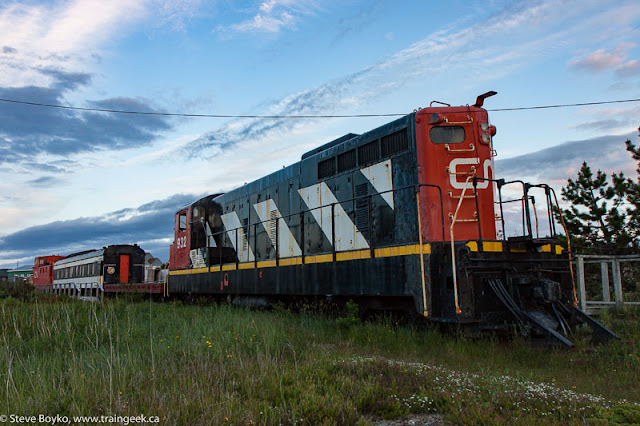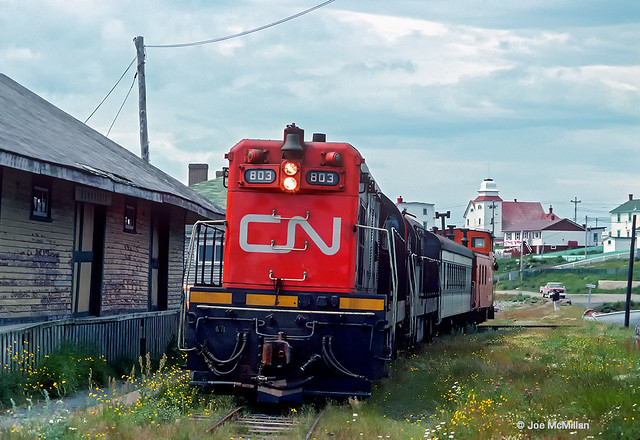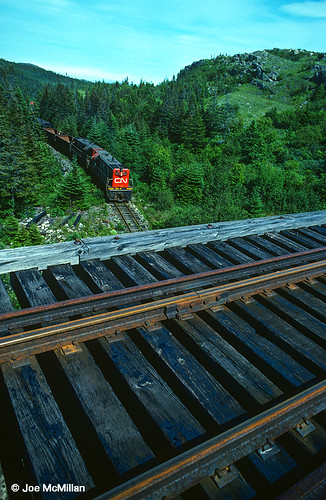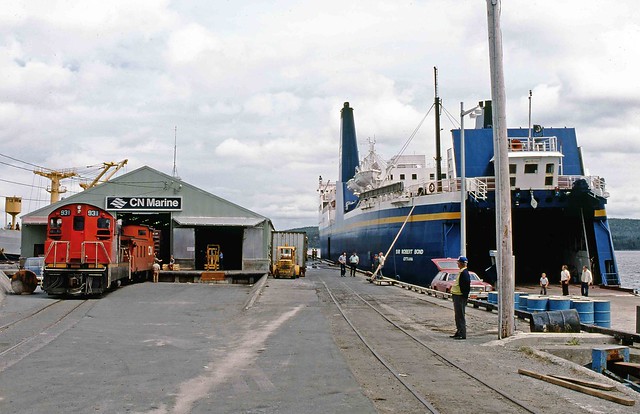 |
| NF110 CN 932 in Bonavista, Newfoundland |
The second place we stayed on our summer vacation in Newfoundland last month was Bonavista. This charming town on the east coast of the Rock is near the tip of the eponymous Bonavista Peninsula.
History of the Bonavista Branch
The Bonavista Branch was the second longest branch line in the system when it was completed at the end of 1911. Stretching 87.9 miles from Shoal Harbour just outside Clarenville, it ran past picturesque Trinity (through the famous Trinity Loop) until it terminated near the ocean in Bonavista.
 |
| Port Union train station and museum |
Construction began on the branch in November 1909 and the branch was officially opened on November 8, 1911. The line was lightly built, like most Newfoundland branches, and only the lighter G8 diesel-electric locomotives were permitted on the line. The last train was mixed train 205, which departed Bonavista on November 23, 1983 with CN/Terra Transport 802 and 803 for power. The branch was suspended shortly afterward due to track conditions and never reopened.
One unique feature of the branch was the
Trinity Loop. The track had to drop more than 30 feet in a short distance to get close to Trinity. This was the only visible train loop in North America; there are others like it but this is the only one where the entire loop is visible.
After the closure of the railway, the Loop was leased by a local businessman and operated as an amusement park until 2004 when it was shut down. Hurricane Igor did serious damage to the remnants of the park in 2010 and it is dubious whether it will ever reopen.
The Bonavista Display
 |
| Bonavista station and locomotive |
The train display is at what was the very end of the Bonavista branch line. The display consists of locomotive 932, a flatcar, a passenger car, and a caboose, along with a speeder. The train station and freight house are both still on site as well.
I walked over there from our hotel (the excellent
Harbour Quarters Inn) on the first evening we were in town. The display is not really front and centre, being midway between the two main north-south roads through town. You could drive through town without even noticing it.
CN 932
 |
| CN 932 and train |
CN 932 is an NF210 locomotive, one of 38 narrow gauge 1200 HP diesel-electric locomotives built for CN for service on Newfoundland. It is a bit out of place in Bonavista as the NF210 and nearly identical NF110 locomotives were prohibited from operating on this branch due to their weight. The lighter G8 locomotives were the only diesels that operated on the Bonavista branch line, to my knowledge.
I didn't take any photos of the flat car, CN 12142.
The Diner Car
 |
| Dining car in Bonavista, NL |
The dining car in the train was built by the Canadian Car and Foundry Company for the Newfoundland Railway in June 1943, as NF 12. It was renumbered to CN 174 in April 1953 and it retired from diner service in July 1973, becoming work car #5018 until after the official closure of the Newfoundland railway.
The car is in CN white and black but has no external markings.
Caboose CN 6060
 |
| Caboose CN 6060 in Bonavista, NL |
The caboose at the end of the train, CN 6060, was built by National Steel Car in December 1962.
The Station and Freight House
 |
| Bonavista Train Station |
The train station, on Station Road, is now home to the T.K. Kelloway Senior Citizens 50+ Club. Based on
some recent town council minutes (PDF) it sounds like it requires some repairs.
The former freight house is still in its original place, on the other end of the train display. It doesn't look like it is being used for anything but it is intact.
 |
| The former freight house in Bonavista |
Here's a great photo by
Joe McMillan of the mixed train in Bonavista on June 30, 1980.

Joe has great photos from
Lethbridge (not the Alberta one) and
Port Rexton on Flickr.
There's also a little speeder in Bonavista. I was surprised to see this on display outside.
 |
| CN speeder in Bonavista |

I
tried to visit the Trinity Loop when we were touring Trinity, but I wasn't 100% sure where it was. I ended up driving up a road for a bit, then getting frustrated and turning around and giving up.
I realized that night that I was on the right road, only a few hundred metres away from the Loop. Shoot.
Instead I'll share this fantastic photo of the mixed train by Joe McMillan, taken from the top of the Trinity Loop.
That's the last of the railway displays I've seen in Newfoundland. There are a number of displays in central and western Newfoundland that I haven't seen yet. The biggest ones are at Bishops Falls and Port Aux Basques, with a variety of cabooses, and freight cars scattered around the island in private use.
The most unique piece on Newfoundland I haven't seen yet is the G8 locomotive at Carbonear,
CN 803, the only G8 remaining on the island. I understand it is looking very shabby. I have seen a G8, though... CN 805 was outside at the Exporail museum in July 2005 when we visited it.
 |
| G8 locomotive CN 805 in Delson, Quebec |
Thanks for reading and taking a virtual tour through the railway sights in eastern Newfoundland!
I'll leave you with a few non-railway images from Bonavista and area... including this photo of me enjoying cod cheeks in Bonavista. They were tasty!
 |
| Bonavista harbour at sunset |
 |
| Inside the Cape Bonavista lighthouse, with its rotating reflectors |
 |
| CCGS Vladykov, docked in Bonavista, NL |
See more!




















































